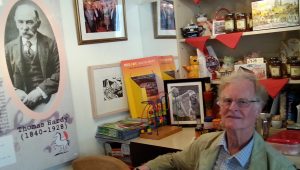
In August I spent two weeks in the UK with my friend Jennifer, mainly doing research at the British Library in London and attending the Historical Novel Society conference in Oxford. In the middle of the trip, I took off alone for what I’d originally planned as a day trip to Dorset, but it turned into a one-night, then a two-night stay because I couldn’t tear myself away.
I’ve always wanted to go to Dorset because it’s Thomas Hardy country. When I tell people I’m a Hardy fan, I tend to get either blank looks or a pained grimace. Quite a few people have had bad experiences with Hardy’s novels and either dislike his tragic, pessimistic outlook on life or his sometimes ponderous prose. One year when I taught Jude the Obscure, a student came to my office and told me I should have warned the class about the dead baby scene (don’t worry, I’ll say no more about that). She said she was on the bus when she read it, and she immediately started crying. She considered me personally responsible for her public embarrassment.
Why do I love Hardy’s novels so much? Because of his larger-than-life characters who are nevertheless deeply human and sympathetic, the landscape that functions as a character itself, the operatic quality of the scenes, and yes, the tragedy. I love tragedy and find it as cathartic as Aristotle argued it should be.
Back to Dorset (also known as Wessex, the name Hardy used for it in his novels). When I disembarked from the train at Dorchester, Dorset’s county town, and stood on the platform smiling at all the possibilities in front of me, an older gentleman approached me and (no doubt noticing the enormous Canada stickers on my suitcase) asked me what brought me to Dorchester.
“Thomas Hardy,” I proclaimed proudly.
“I’ve written about Hardy in my book,” he replied, and we were instant friends. He showed me around for a bit, then we parted with a plan to get together the next morning for coffee.

The next day I plunged into literary tourist mode. After meeting my new friend Dr. John at a delightful café called The Horse with the Red Umbrella, I walked to Max Gate, the house Hardy designed and lived in until his death. I plopped myself down on a sofa in the parlour and had a wonderful talk with Judy #1, museum guide and fellow Hardy fan, about Hardy’s life and work. If you can’t find a Hardy fan in Hardy’s own house, where can you find one? Eventually I went upstairs and met Judy #2, with whom I had another nice chat. Apparently you can’t work at Hardy’s house unless your name is Judy!
The house was fascinating in its own right, but what interested me most was the attic where Hardy’s first wife, Emma, decided to move about twenty years into their marriage. I knew Hardy had been married twice but I knew very little about his wives. At Max Gate, I became fascinated by Emma, who had literary ambitions of her own, loved animals, and in later life supported women’s suffrage. What had made her move out of the marital bedroom into the tiny two-room attic? Judy #1 assured me this was no “madwoman in the attic” scenario. It was Emma’s choice to move into the attic, and her faculties were intact.
The dark little attic seemed sad, even after Judy #2 explained that in Emma’s time it was painted white and was more cheerful-looking. Apparently Emma came downstairs sometimes, mainly when Hardy had literary friends over. She loved to talk to other writers. But what a disastrous marriage!
Judy #2 told me a story about the day Emma died. She was still living in the attic, and her maid ran down to Hardy’s study and begged him to come upstairs because her mistress was seriously ill. Before going upstairs, he ordered the maid to straighten her collar (clearly not one of his finer moments). When he went up and saw how sick Emma really was, he was guilt-stricken, and he stayed that way for some time after her death. Most of the better-known poems he wrote about Emma were written during this wave of guilt and grief after she died. Inconveniently, he continued to write these poems while married to his second wife, Florence.

Pondering Hardy’s marital problems, I left Max Gate and took a path that the tourist map promised would lead me on a pleasant 90-minute walk on a public path through meadows, woods, and fields to another Hardy landmark, the cottage where he was born. I proceeded to get thoroughly lost.
Fortunately, I soon came across a man and woman intently perusing a large map. It turned out that they, too, were trying to find Hardy’s cottage. I asked if I could tag along, and that’s how David, Joyce and I became friends while unknowingly walking in large circles in the Dorset countryside. Instead of a pleasant 90-minute walk, it became an arduous three-and-a-half-hour adventure. At the end of it, we calculated that we had walked at least 15 miles that day (including the walking we had done before we met).

Why didn’t we ask for directions, you say? We did. Some people told us to take the right-hand path, others told us to take the left. We had 3 or 4 tourist/hiking maps among us, and all had different directions. The path was not marked. The few maps or signs we did see were like this one in the photo.
After we finally reached our destination and I had a chance to rest and think about everything I’d learned that day, I found myself pondering the problem of confusing an author’s writings with his life, as well as what’s called in literary studies the “intentional fallacy.” We English professors constantly tell our students not to speculate about an author’s intentions when they interpret a text. Part of the legacy of postmodernism is that the reader has become more important than the author, and the text means more than its author intended. Trying to figure out the author’s intentions takes the focus off the text and can lead to a narrow biographical focus. Not every character an author creates corresponds to real people in his life. But students often resist being directed away from the author’s intentions and life.
As a properly-trained English major, I have no trouble ignoring the author’s life and intentions when studying and interpreting a literary text. As a result of this training, I actually knew much less about Hardy’s life than I did about his work and was surprised by what I learned in Dorset. My view of his love poems, so many of which were written after Emma’s death, completely changed. I’m still not sure whether the change is for better or for worse (no marital pun intended!).
I’ve always suspected that of the many authors whose writing I enjoy, I wouldn’t like most of them as people. Enid Blyton comes to mind immediately, but she’s an extreme example. I probably couldn’t stay in the same room for ten minutes with most of the male Victorians. I almost certainly wouldn’t like Thomas Hardy. But does this matter? Can’t we enjoy authors’ work without liking their personal traits or preferences?
I’ve heard more than one person say that if someone is a good writer, they must surely be a good person, yet people never talk about whether a visual artist or musician is a good person. Why, then, the preoccupation with a writer’s morality? I don’t have an answer. Do you?
Wessex Wanderings
2 Comments
Leave a Reply
You must be logged in to post a comment.
Aaahhhh!!! I LOVE Thomas Hardy!!! And I have never met anyone else who loves him! I just read Tess in 2012 (that’s when I fell in love) and then Jude in 2013. I recently got my hands on a copy of Return of the Native and am so excited for it. I am so glad to know you’re a fellow Hardy fan!
Hi Lauren! I’m thrilled that you’re also a Hardy fan (we are few and far between). Return of the Native is my favourite Hardy novel (Jude is a very close second), so I’m very interested to find out what you think about it. Do let me know when you finish it!